1999 TOYOTA LAND CRUISER towing
[x] Cancel search: towingPage 84 of 202

New L/C100(U)
92
The gauge indicates the engine coolant
temperature when the ignition switch is
on. The engine operating temperature
will vary with changes in weather and
engine load.
If the needle points to the red zone or
higher, stop your vehicle and allow the
engine to cool.
Your vehicle may overheat during severe
operating conditions, such as: � Driving up a long hill on a hot day.
� Reducing speed or stopping after high
speed driving.
� Idling for a long period with the air
conditioning on in stop- and- go traffic.
� Towing a trailer.
NOTICE
�Do not remove the thermostat in
the engine cooling system as thismay cause the engine to overheat.The thermostat is designed to con-
trol the flow of coolant to keep thetemperature of the engine withinthe specified operating range.
�Do not continue driving with anoverheated engine. See ºIf your ve-hicle overheatsº in Part 4.
Oil pressure gauge
Idling
Normal driving
The oil pressure gauge indicates engine
oil pressure when the ignition switch is
on. Check it while driving to make sure
that the needle is in the proper range.
If the oil pressure should stay below the
normal range, pull off the road to a safe
place and stop the engine immediately.
Call a Toyota dealer or qualified repair
shop for assistance.
Oil pressure may not build up when the
oil level is too low. The oil pressure
gauge is not designed to indicate oil level,
and the oil level must be checked using
the level dipstick.
Engine coolant temperature
gauge
Page 93 of 202
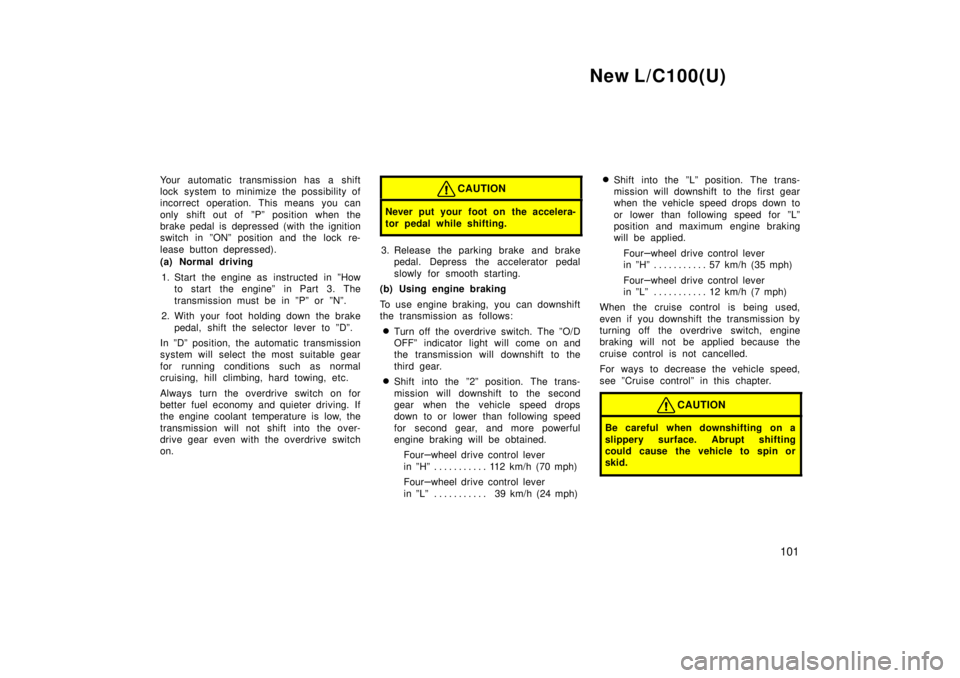
New L/C100(U)101
Your automatic transmission has a shift
lock system to minimize the possibility of
incorrect operation. This means you can
only shift out of ºPº position when the
brake pedal is depressed (with the ignition
switch in ºONº position and the lock re-
lease button depressed).
(a) Normal driving
1. Start the engine as instructed in ºHow to start the engineº in Part 3. The
transmission must be in ºPº or ºNº.
2. With your foot holding down the brake pedal, shift the selector lever to ºDº.
In ºDº position, the automatic transmission
system will select the most suitable gear
for running conditions such as normal
cruising, hill climbing, hard towing, etc.
Always turn the overdrive switch on for
better fuel economy and quieter driving. If
the engine coolant temperature is low, the
transmission will not shift into the over-
drive gear even with the overdrive switchon.
CAUTION
Never put your foot on the accelera-
tor pedal while shifting.
3. Release the parking brake and brake pedal. Depress the accelerator pedal
slowly for smooth starting.
(b) Using engine braking
To use engine braking, you can downshift
the transmission as follows:
� Turn off the overdrive switch. The ºO/D
OFFº indicator light will come on and
the transmission will downshift to the
third gear.
� Shift into the º2º position. The trans-
mission will downshift to the second
gear when the vehicle speed drops
down to or lower than following speed
for second gear, and more powerful
engine braking will be obtained.
Four ±wheel drive control lever
in ºHº 112 km/h (70 mph) . . . . . . . . . . .
Four ±wheel drive control lever
in ºLº 39 km/h (24 mph) . . . . . . . . . . . �
Shift into the ºLº position. The trans-
mission will downshift to the first gear
when the vehicle speed drops down to
or lower than following speed for ºLº
position and maximum engine braking
will be applied.
Four ±wheel drive control lever
in ºHº 57 km/h (35 mph) . . . . . . . . . . .
Four ±wheel drive control lever
in ºLº 12 km/h (7 mph) . . . . . . . . . . .
When the cruise control is being used,
even if you downshift the transmission by
turning off the overdrive switch, engine
braking will not be applied because the
cruise control is not cancelled.
For ways to decrease the vehicle speed,
see ºCruise controlº in this chapter.
CAUTION
Be careful when downshifting on a
slippery surface. Abrupt shifting
could cause the vehicle to spin or
skid.
Page 94 of 202
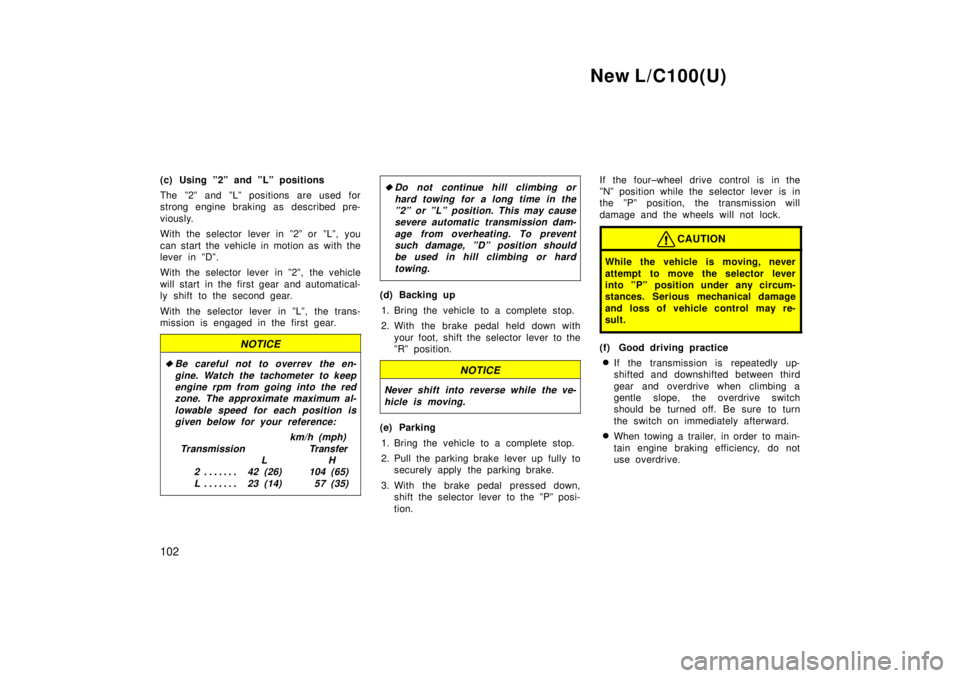
New L/C100(U)
102
(c) Using º2º and ºLº positions
The º2º and ºLº positions are used for
strong engine braking as described pre-
viously.
With the selector lever in º2º or ºLº, you
can start the vehicle in motion as with the
lever in ºDº.
With the selector lever in º2º, the vehicle
will start in the first gear and automatical-
ly shift to the second gear.
With the selector lever in ºLº, the trans-
mission is engaged in the first gear.
NOTICE
�Be careful not to overrev the en-
gine. Watch the tachometer to keepengine rpm from going into the red zone. The approximate maximum al-
lowable speed for each position isgiven below for your reference:
km/h (mph)
Transmission Transfer L H
2 42 (26) 104 (65) . . . . . . .
L 23 (14) 57 (35) . . . . . . .
�Do not continue hill climbing or
hard towing for a long time in theº2º or ºLº position. This may causesevere automatic transmission dam-
age from overheating. To preventsuch damage, ºDº position shouldbe used in hill climbing or hard
towing.
(d) Backing up
1. Bring the vehicle to a complete stop.
2. With the brake pedal held down with your foot, shift the selector lever to the
ºRº position.
NOTICE
Never shift into reverse while the ve-
hicle is moving.
(e) Parking
1. Bring the vehicle to a complete stop.
2. Pull the parking brake lever up fully to securely apply the parking brake.
3. With the brake pedal pressed down, shift the selector lever to the ºPº posi-
tion. If the four±wheel drive control is in the
ºNº position while the selector lever is in
the ºPº position, the transmission will
damage and the wheels will not lock.
CAUTION
While the vehicle is moving, never
attempt to move the selector lever
into ºPº position under any circum-
stances. Serious mechanical damage
and loss of vehicle control may re-
sult.
(f) Good driving practice
� If the transmission is repeatedly up-
shifted and downshifted between third
gear and overdrive when climbing a
gentle slope, the overdrive switch
should be turned off. Be sure to turn
the switch on immediately afterward.
� When towing a trailer, in order to main-
tain engine braking efficiency, do not
use overdrive.
Page 153 of 202

New L/C100(U)161
DRUM- IN- DISC TYPE PARKING BRAKE SYSTEM
Your vehicle has a drum- in- disc type
parking brake system. This type of brake
system n
eeds bedding- down of the brake
shoes periodically or whenever the parking
brake shoes and/or drums are replaced.
Have your Toyota dealer perform the bed-
ding- down. Brake pad wear limit indicators
The brake pad wear limit indicators on
your disc brakes give a warning noise
when the brake pads are worn to where
replacement is required.
If you hear a squealing or scraping noise
while driving, have the brake pads
checked and replaced by your Toyota
dealer as soon as possible. Expensive ro-
tor damage can result if the pads are not
replaced when necessary.Luggage stowage pr
ecautions
When stowing luggage or cargo in or on
the vehicle, observe the following: � Put luggage or cargo in the luggage
compartment when at all possible. Be
sure all items are secured in place.
� Be careful to keep the vehicle bal-
anced. Locating the weight as far for-
ward as possible helps maintain the
balance.
� For better fuel economy, do not carry
unneeded weight.CAUTION
�To prevent luggage or packages
from sliding forward during braking,
do not stack anything in the lug-
gage compartment higher than the
seatbacks.
� Do not place anything on the flat-
tened seat or it may slide forward
during braking.
Page 159 of 202
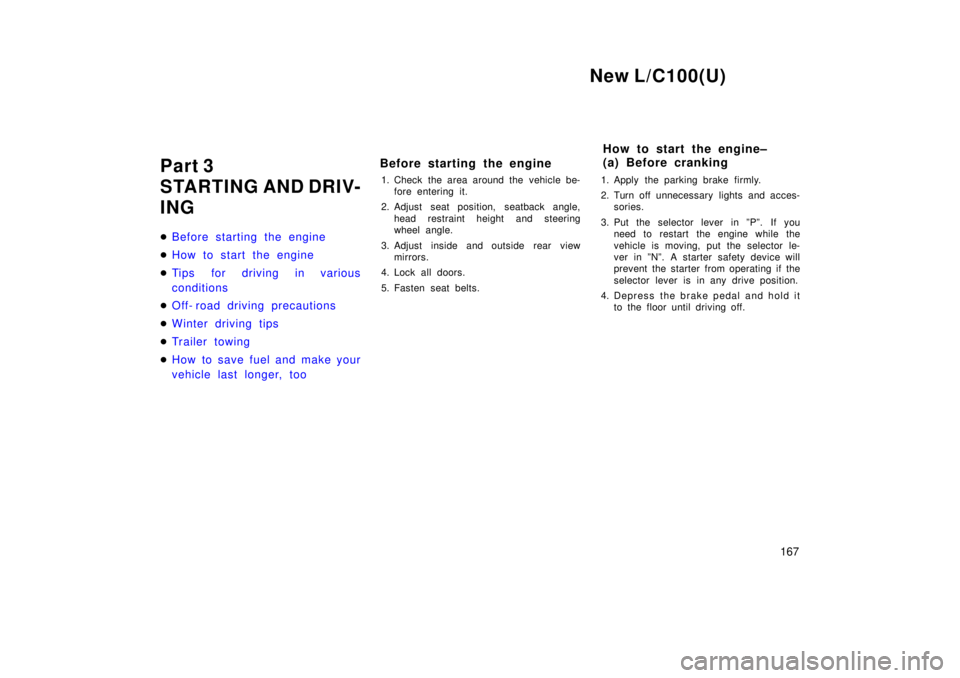
New L/C100(U)167
Part 3
STARTING AND DRIV-
ING �
Before starting the engine
�How to start the engine
�Tips for driving in various
conditions
�Off- road driving precautions
�Winter driving tips
�Tr ailer towing
�How to save fuel and make your
vehicle last longer, too
Before starting the engine
1. Check the area around the vehicle be- fore entering it.
2. Adjust seat position, seatback angle, head restraint height and steering
wheel angle.
3. Adjust inside and outside rear view mirrors.
4. Lock all doors.
5. Fasten seat belts. 1. Apply the parking brake firmly.
2. Turn off unnecessary lights and acces-
sories.
3. Put the selector lever in ºPº. If you need to restart the engine while the
vehicle is moving, put the selector le-
ver in ºNº. A starter safety device will
prevent the starter from operating if the
selector lever is in any drive position.
4. Depress the brake pedal and hold it to the floor until driving off.
How to start the engine±
(a) Before cranking
Page 164 of 202
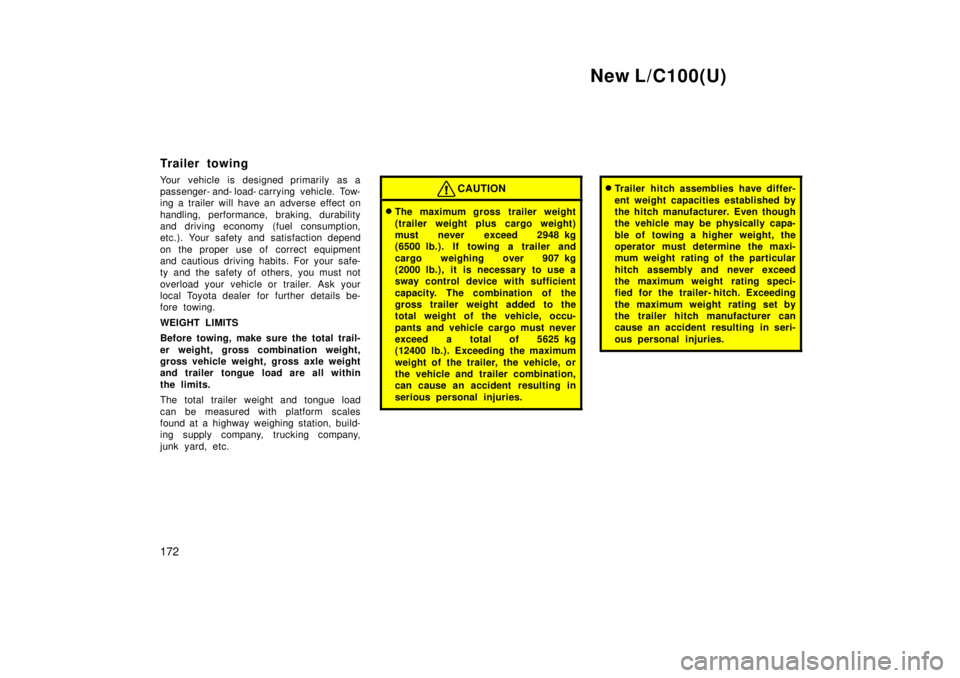
New L/C100(U)
172
Trailer towing
Your vehicle is designed primarily as a
passenger- and- load- carrying vehicle. Tow-
ing a trailer will have an adverse effect on
handling, performance, braking, durab
ility
and driving economy (fuel consumption,
etc.). Your safety and satisfaction depend
on the proper use of correct equipment
and cautious driving habits. For your safe-
ty and the safety of others, you must not
overload your vehicle or trailer. Ask your
local Toyota dealer for further details be-
fore towing.
WEIGHT LIMITS
Before towing, make sure the total trail-
er weight, gross combination weight,
gross vehicle weight, gross axle weight
and trailer tongue load are all within
the limits.
The total trailer weight and tongue load
can be measured with platform scales
found at a highway weighing station, build-
ing supply company, trucking company,
junk yard, etc.
CAUTION
� The maximum gross trailer weight
(trailer weight plus cargo weight)
must never exceed 2948 kg
(6500 lb.). If towing a trailer and
cargo weighing over 907 kg
(2000 lb.), it is necessary to use a
sway control device with sufficient
capacity. The combination of the
gross trailer weight added to the
total weight of the vehicle, occu-
pants and vehicle cargo must never
exceed a total of 5625 kg
(12400 lb.). Exceeding the maximum
weight of the trailer, the vehicle, or
the vehicle and trailer combination,
can cause an accident resulting in
serious personal injuries.
�Trailer hitch assemblies have differ-
ent weight capacities established by
the hitch manufacturer. Even though
the vehicle may be physically capa-
ble of towing a higher weight, the
operator must determine the maxi-
mum weight rating of the particular
hitch assembly and never exceed
the maximum weight rating speci-
fied for the trailer- hitch. Exceeding
the maximum weight rating set by
the trailer hitch manufacturer can
cause an accident resulting in seri-
ous personal injuries.
Page 165 of 202
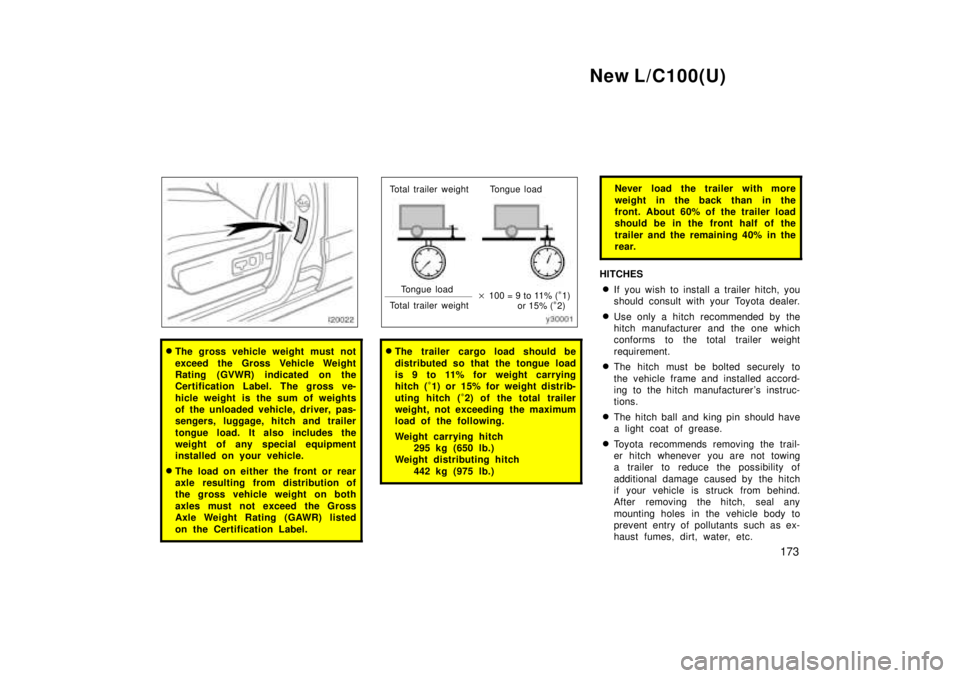
New L/C100(U)173
�The gross vehicle weight must not
exceed the Gross Vehicle Weight
Rating (GVWR) indicated on the
Certification Label. The gross ve-
hicle weight is the sum of weights
of the unloaded vehicle, driver, pas-
sengers, luggage, hitch and trailer
tongue load. It also includes the
weight of any special equipment
installed on your vehicle.
� The load on either the front or rear
axle resulting from distribution of
the gross vehicle weight on both
axles must not exceed the Gross
Axle Weight Rating (GAWR) listed
on the Certification Label.
Total trailer weight Tongue load
Tongue load
Total trailer weight �
100 = 9 to 11% ( *
1)
or 15% ( *
2)
� The trailer cargo load should be
distributed so that the tongue load
is 9 to 11% for weight carrying
hitch ( *
1) or 15% for weight distrib-
uting hitch ( *
2) of the total trailer
weight, not exceeding the maximum
load of the following.
Weight carrying hitch 295 kg (650 lb.)
Weight distributing hitch
442 kg (975 lb.)
Never load the trailer with more
weight in the back than in the
front. About 60% of the trailer load
should be in the front half of the
trailer and the remaining 40% in the
rear.
HITCHES
� If you wish to install a trailer hitch, you
should consult with your Toyota dealer.
� Use only a hitch recommended by the
hitch manufacturer and the one which
conforms to the total trailer weight
requirement.
� The hitch must be bolted securely to
the vehicle frame and installed accord-
ing to the hitch manufacturer 's instruc-
tions.
� The hitch ball and king pin should have
a light coat of grease.
� Toyota recommends removing the trail-
er hitch whenever you are not towing
a trailer to reduce the possib ility of
additional damage caused by the hitch
if your vehicle is struck from behind.
After removing the hitch, seal any
mounting holes in the vehicle body to
prevent entry of pollutants such as ex-
haust fumes, dirt, water, etc.
Page 167 of 202
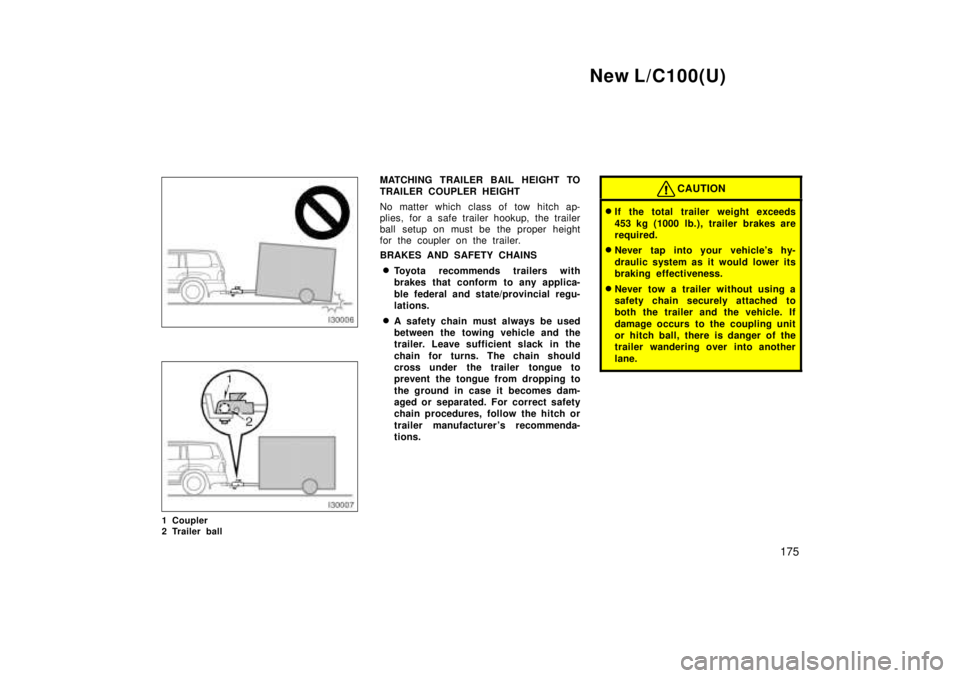
New L/C100(U)175
1 Coupler
2 Trailer ball MATCHING TRAILER BAIL HEIGHT TO
TRAILER COUPLER HEIGHT
No matter which class of tow hitch ap-
plies, for a safe trailer hookup, the trailer
ball setup on must be the proper height
for the coupler on the trailer.
BRAKES AND SAFETY CHAINS
� Toyota recommends trailers with
brakes that conform to any applica-
ble federal and state/provincial regu-
lations.
� A safety chain must always be used
between the towing vehicle and the
trailer. Leave sufficient slack in the
chain for turns. The chain should
cross under the trailer tongue to
prevent the tongue from dropping to
the ground in case it becomes dam-
aged or separated. For correct safety
chain procedures, follow the hitch or
trailer manufacturer 's recommenda-
tions.
CAUTION
�If the total trailer weight exceeds
453 kg (1000 lb.), trailer brakes are
required.
� Never tap into your vehicle's hy-
draulic system as it would lower its
braking effectiveness.
� Never tow a trailer without using a
safety chain securely attached to
both the trailer and the vehicle. If
damage occurs to the coupling unit
or hitch ball, there is danger of the
trailer wandering over into another
lane.